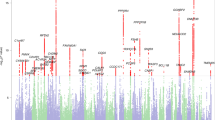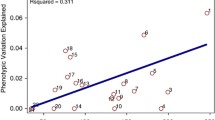Abstract
Reading disability (RD), or dyslexia, is the most common learning disability with a prevalence rate of ~5%–10% in school-age children. RD is highly heritable with evidence of a neurobiological origin. Linkage studies have identified several quantitative trait loci (QTLs) for RD. The QTL on chromosome 6p21.3 has been independently replicated by several groups and spans a 16.4-Mb (13.8 cM) interval from D6S109 to D6S291. In this study, we performed sib-pair linkage analyses with Haseman–Elston and DeFries–Fulker methods to define more accurately the QTL interval. Linkage was assessed by using five quantitative phenotypes, including a composite measure of reading performance and four component phenotypes. When probands were selected for severe scores, single- and multi-point analyses showed significant linkage with all five phenotypes, converging over an interval of ~3.24 Mb spanning D6S1597 to D6S1571. Maximal linkage converged at marker D6S1554 across phenotypes. Out of 12 genes in the linkage interval, ten clustered within ~680 kb and were selected for association analysis based on central nervous system expression and putative function. Marker-trait associations were assessed by using QTDT (a general test of association for quantitative traits) and the family-based association test (FBAT), and haplotype analysis was performed by using FBAT and the GeneHunter Transmission/Disequilibrium Test TDT. Marker associations were detected in five of the ten genes, results that were corroborated by our haplotype TDT analysis. The results of the association study have thereby allowed us to significantly reduce the number of possible candidate genes and to prioritize genes for further mutation screening.



Similar content being viewed by others
References
Abecasis GR, Cookson WO (2000) GOLD—graphical overview of linkage disequilibrium. Bioinformatics 16:182–183
Abecasis GR, Cardon LR, Cookson WOC (2000) A general test of association for quantitative traits in nuclear families. Am J Hum Genet 66:279–292
Abecasis GR, Cherny SS, Cookson WO, Cardon LR (2002) Merlin—rapid analysis of dense genetic maps using sparse gene flow trees. Nat Genet 30:97–101
Allison DB (1997) Transmission-disequilibrium tests for quantitative traits. Am J Hum Genet 60:676–690
Cardon LR, Smith SD, Fulker DW, Kimberling WJ, Pennington BF, DeFries JC (1994) Quantitative trait locus for reading disability on chromosome 6. Science 266:276–279
Cheng C, Xu J, Ye X, Dai J, Wu Q, Zeng L, Wang L, Zhao W, Ji C, Gu S, Xie Y, Mao Y (2002) Cloning, expression and characterization of a novel human VMP gene. Mol Biol Rep 29:281–286
DeFries JC, Fulker DW (1985) Multiple regression analysis of twin data. Behav Genet 15:467–473
Dunn LM, Markwardt FC (1970) Peabody individual achievement test examiner’s manual. American Guidance Service, Circle Pines
Elston RC, Buxbaum S, Jacobs KB, Olson JM (2000) Haseman and Elston revisited. Genet Epidemiol 19:1–17
Fagerheim T, Raeymaekers P, Tonnessen FE, Pedersen M, Tranebjaerg L, Lubs HA (1999) A new gene (DYX3) for dyslexia is located on chromosome 2. J Med Genet 36:664–669
Field LL, Kaplan BJ (1998) Absence of linkage of phonological coding dyslexia to chromosome 6p23–p21.3 in a large family data set. Am J Hum Genet 63:1448–1456
Fisher SE, Marlow A, Lamb J, Maestrini E, Williams DF, Richardson AJ, Weeks DE, Stein JF, Monaco AP (1999) A quantitative-trait locus on chromosome 6p influences different aspects of developmental dyslexia. Am J Hum Genet 64:146–156
Fisher SE, Francks C, Marlow AJ, MacPhie IL, Newbury DF, Cardon LR, Ishikawa-Brush Y, Richardson AJ, Talcott JB, Gayán J, Olson RK, Pennington BF, Smith SD, DeFries JC, Stein JF, Monaco AP (2002) Independent genome-wide scans identify a chromosome 18 quantitative-trait locus influencing dyslexia. Nat Genet 30:86–91
Fulker D, Cardon L, DeFries J, Kimberling W, Pennington B, Smith S (1991) Multiple regression analysis of sib-pair data on reading to detect quantitative trait loci. Reading Writing Interdis J 3:299–313
Gayán J, Olson RK (2001) Genetic and environmental influences on orthographic and phonological skills in children with reading disabilities. Dev Neuropsychol 20:483–507
Gayán J, Smith SD, Cherny SS, Cardon LR, Fulker DW, Brower AM, Olson RK, Pennington BF, DeFries JC (1999) Quantitative-trait locus for specific language and reading deficits on chromosome 6p. Am J Hum Genet 64:157–164
Grigorenko EL, Wood FB, Meyer MS, Hart LA, Speed WC, Shuster A, Pauls DL (1997) Susceptibility loci for distinct components of developmental dyslexia on chromosomes 6 and 15. Am J Hum Genet 60:27–39
Grigorenko EL, Wood FB, Meyer MS, Pauls DL (2000) Chromosome 6p influences on different dyslexia-related cognitive processes: further confirmation. Am J Hum Genet 66:715–723
Grigorenko EL, Wood FB, Golovyan L, Meyer M, Romano C, Pauls D (2003) Continuing the search for dyslexia genes on 6p. Am J Med Genet 118B:89–98
Habib M (2000) The neurological basis of developmental dyslexia: an overview and working hypothesis. Brain 123:2373–2399
Haseman JK, Elston RC (1972) The investigation of linkage between a quantitative trait and a marker locus. Behav Genet 2:3–19
Horvath S, Xu X, Laird N (2001) The family based association test method: strategies for studying general genotype-phenotype associations. Euro J Hum Gen 9:301–306
Kaplan DE, Gayán J, Ahn J, Won T-W, Pauls D, Olson RK, DeFries JC, Wood F, Pennington BF, Page GP, Smith SD, Gruen JR (2002) Evidence for linkage and association with reading disability, on 6p21.3–22. Am J Hum Genet 70:1287–1298
Kruglyak L, Lander ES (1995) Complete multipoint sib-pair analysis of qualitative and quantitative traits. Am J Hum Genet 57:439–454
Lerner JW (1989) Educational interventions in learning disabilities. J Am Acad Child Adolesc Psychiatry 28:326–331
Lessem JL, Cherny SS (2001) DeFries–Fulker multiple regression analysis of sibship QTL data: a SAS macro. Bioinformatics 17:371–372
Lyon GR (1995) Toward a definition of dyslexia. Ann Dyslexia 45:3–27
Malfroy L, Roth MP, Carrington M, Borot N, Volz A, Ziegler A, Coppin H (1997) Heterogeneity in rates of recombination in the 6-Mb region telomeric to the human major histocompatibility complex. Genomics 43:226–231
McIntyre LM, Martin ER, Simonsen KL, Kaplan NL (2000) Circumventing multiple testing: a multilocus Monte Carlo approach to testing for association. Genet Epidemiol 19:18–29
Morris DW, Robinson L, Turic D, Duke M, Webb V, Milham C, Hopkin E, Pound K, Fernando S, Easton M, Hamshere M, Williams N, McGuffin P, Stevenson J, Krawczak M, Owen MJ, O’Donovan MC, Williams J (2000) Family-based association mapping provides evidence for a gene for reading disability on chromosome 15q. Hum Mol Genet 9:843–848
Nopola-Hemmi J, Myllyluoma B, Haltia T, Taipale M, Ollikainen V, Ahonen T, Voutilainen A, Kere J, Widen E (2001) A dominant gene for developmental dyslexia on chromosome 3. J Med Genet 38:658–664
Nöthen MM, Schulte-Körne G, Grimm T, Cichon S, Vogt IR, Müller-Myhsok B, Propping P, Remschmidt H (1999) Genetic linkage analysis with dyslexia: evidence for linkage of spelling disability to chromosome 15. Eur Child Adolesc Psychiatry 8(Suppl 3):56–59
Olson R, Wise B, Conners F, Rack J, Fulker D (1989) Specific deficits in component reading and language skills: Genetic and environmental influences. J Learn Disabil 22:339–348
Petryshen TL, Kaplan BJ, Liu MF, Field LL (2000) Absence of significant linkage between phonological coding dyslexia and chromosome 6p23–21.3, as determined by use of quantitative-trait methods: confirmation of qualitative analyses. Am J Hum Genet 66:708–714
Petryshen TL, Kaplan BJ, Lui MF, French NS de, Tobias R, Hughes ML, Field LL (2001) Evidence for a susceptibility locus on chromosome 6q influencing phonological coding dyslexia. Am J Med Genet 105:507–517
Pype S, Declercq W, Ibrahimi A, Michiels C, Van Rietschoten JG, Dewu N, Boer M de, Vandenabeele P, Huylebroeck D, Remacle JE (2000) TTRAP, a novel protein that associates with CD40, tumor necrosis factor (TNF) receptor-75 and TNF receptor-associated factors (TRAFs), and that inhibits nuclear factor-kappa B activation. J Biol Chem 275:18586–18593
Rabin M, Wen XL, Hepburn M, Lubs HA, Feldman E, Duara R (1993) Suggestive linkage of developmental dyslexia to chromosome 1p34–p36. Lancet 342:178
Rabinowitz D (1997) A transmission disequilibrium test for quantitative trait loci. Hum Hered 47:342–350
Risch N, Teng J (1998) The relative power of family-based and case-control designs for linkage linkage disequilibrium studies of complex human diseases I. DNA pooling. Gen Res 8:1273–1288
S.A.G.E. (2002) Statistical analysis for genetic epidemiology. Computer program package available from Statistical Solutions, Cork
Shaywitz SE, Shaywitz BA, Fletcher JM, Escobar MD (1990) Prevalence of reading disability in boys and girls. JAMA 264:998–1002
Spielman RS, McGinnis RE, Ewens WJ (1993) Transmission test for linkage disequilibrium: the insulin gene region and insulin-dependent diabetes mellitus (IDDM). Am J Hum Genet 52:506–516
Wechsler D (1974) Wechsler’s intelligence scale for children, revised examiner’s manual. The Psychological Corporation, New York
Wechsler D (1981) Wechsler adult intelligence scale, revised examiner’s manual. The Psychological Corporation, New York
Acknowledgments
We are grateful to all of the families who participated in this study, which was supported in part by National Institutes of Health (NIH) NICHD grant 5P50 HD27802–12 and NIH grant 5-R01 HD34812. Some of the results presented here were obtained by use of the program package S.A.G.E. from the Department of Epidemiology and Biostatistics, Case Western Reserve University, Cleveland, which is supported by US Public Health Service resource grant 1 P41 RR03655 from the National Center for Research Resources.
Author information
Authors and Affiliations
Corresponding author
Rights and permissions
About this article
Cite this article
Deffenbacher, K.E., Kenyon, J.B., Hoover, D.M. et al. Refinement of the 6p21.3 quantitative trait locus influencing dyslexia: linkage and association analyses. Hum Genet 115, 128–138 (2004). https://doi.org/10.1007/s00439-004-1126-6
Received:
Accepted:
Published:
Issue Date:
DOI: https://doi.org/10.1007/s00439-004-1126-6




